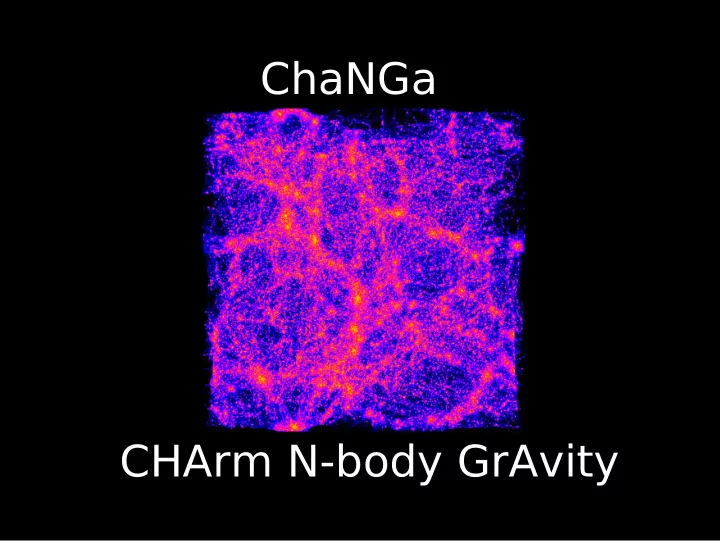

ChaNGa CHArm N-body GrAvity
Laxmikant Kale Thomas Quinn Filippo Gioachin Graeme Lufkin Pritish Jetley Joachim Stadel Celso Mendes Amit Sharma
Outline ● Scientific background – How to build a Galaxy – Types of Simulations – Simulation Challenges ● ChaNGa and those Challenges – Features – Tree gravity – Load balancing – Multistepping ● Future Challenges – Needed Simulations – Technology Challenges
Cosmology: How does this ... Image courtesy NASA/WMAP
... turn into this?
Computational Cosmology ● CMB gives fluctuations of 1e-5 ● Galaxies are overdense by 1e7 ● It happens through Gravitational Collapse ● Making testable predictions from a cosmological hypothesis requires – Non-linear, dynamic calculation – e.g. Computer simulation
Simulation process ● Start with fluctuations based on Dark Matter properties ● Follow model analytically (good enough to get CMB) ● Create a realization of these fluctuations in particles. ● Follow the motions of these particles as they interact via gravity. ● Compare final distribution of particles with observed properties of galaxies.
Simulating galaxies: Procedure 1. Simulate 100 Mpc volume at 10-100 kpc resolution 2. Pick candidate galaxies for further study 3. Resimulate galaxies with same large scale structure but with higher resolution, and lower resolution in the rest of the computational volume. 4. At higher resolutions, include gas physics and star formation.
Stars Gas Dark Matter
Types of simulations “Uniform” Star Zoom Volume Cluster In 05/02/08 Parallel Programming Laboratory @ UIUC 11
Computational Challenges ● Large spacial dynamic range: > 100 Mpc to < 1 kpc – Hierarchical, adaptive gravity solver is needed ● Large temporal dynamic range: 10 Gyr to 1 Myr – Multiple timestep algorithm is needed ● Gravity is a long range force – Hierarchal information needs to go across processor domains
The existing code: ● Multi - Platform ● Massively Parallel (100s; 1000s on large sims) ● Treecode with periodic boundary conditions ● Multi-stepping (but bad load balancing) ● Hydrodynamics (via SPH) with radiative cooling ● UV background ● Star Formation ● Supernovae feedback into thermal energy
ChaNGa Features ● Tree-based gravity solver ● High order multipole expansion ● Periodic boundaries (if needed) ● Individual multiple timesteps ● Dynamic load balancing with choice of strategies ● Checkpointing ● Visualization ● Built from the ground up on Charm++
Need for high multipole order
Space decomposition TreePiece 1 TreePiece 2 TreePiece 3 ... Parallel Programming Laboratory @ UIUC 16 05/02/08
Basic algorithm ... ● Newtonian gravity interaction – Each particle is influenced by all others: O( n ² ) algorithm ● Barnes-Hut approximation: O( n log n ) – Influence from distant particles combined into center of mass Parallel Programming Laboratory @ UIUC 17 05/02/08
... in parallel ● Remote data – need to fetch from other processors ● Data reusage – same data needed by more than one particle Parallel Programming Laboratory @ UIUC 18 05/02/08
Overall algorithm Processor n Processor 1 Start computation TreePiece C TreePiece B TreePiece A miss local work global work (low priority)remote CacheManager TreePiece on Processor 2 local work global work remote prefetch work e d o n NO: fetch local work s t (low priority) e u present? q e reply with prefetch r work remote visit of (low priority) requested data YES: return the tree visit of the tree callback buffer End computation High priority High priority Parallel Programming Laboratory @ UIUC 19 05/02/08
Scaling: comparison Uniform 3M on Tungsten 05/02/08 Parallel Programming Laboratory @ UIUC 20
Load balancing with GreedyLB Zoom In 5M on 1,024 BlueGene/L processors 5.6s 6.1s 4x messages 05/02/08 Parallel Programming Laboratory @ UIUC 21
Load balancing with OrbRefineLB Zoom in 5M on 1,024 BlueGene/L processors 5.6s 5.0s 05/02/08 Parallel Programming Laboratory @ UIUC 22
Scaling with load balancing Number of Processors x Execution Time per Iteration (s) 05/02/08 Parallel Programming Laboratory @ UIUC 23
Timestepping Challenges ● 1/ m particles need m times more force evaluations ● Naively, simulation cost scales as N^(4/3)ln(N) – This is a problem when N ~ 1e9 or greater ● If each particle an individual timestep scaling reduces to N (ln(N))^2 ● A difficult dynamic load balancing problem
Timestepping and Load Balancing
Cosmo Loadbalancer ● Use Charm++ measurement based load balancer ● Modification: provide LB database with information about timestepping. – “Large timestep”: balance based on previous Large step – “Small step” balance based on previous small step
Results on 3 rung example 429s 228s 613s
Summary ● Cosmological simulations provide a challenges to parallel implementations – Non-local data dependencies – Hierarchical in space and time ● ChaNGa has been successful in addressing this challenges using Charm++ features – Message priorities – New load balancers
Future ● Changa currently in use in high time dynamic range simulations: galactic nuclei ● New Physics – Smooth particle hydrodynamics ● Better gravity algorithms – Fast multipole method – New domain decomposition/load balancing strategies ● Generic tree walk to enable new algorithms
Have We converged? Weinberg & Katz (2007)
Computing Challenge Summary ● The Universe is big => we will always be pushing for more resources ● New algorithm efforts will be made to make efficient use of the resources we have – Efforts made to abstract away from machine details – Parallelization efforts need to depend on more automated processes.
Recommend
More recommend